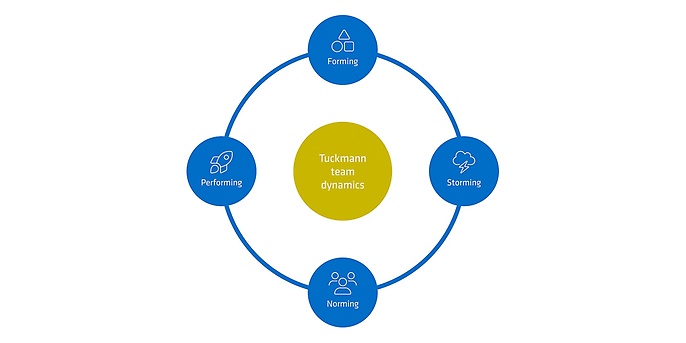20. July 2023 By Arman Kohli
Servant Leadership
Unlike traditional leadership models in which the manager exercises power and control over the team, servant leadership revolves around empathy, collaboration and empowering employees. Servant leaders support their team members, promote open communication and create an environment in which all the members of the team feel heard and respected. There are various approaches to positively influence team dynamics, cohesion and dedication, which are an essential part of organisational consultancy.
The definition of this leadership style is shaped by agile working methods and the ITIL 4 framework. In ITIL, this idea is strongly driven by the service mindset, and an increasing number of modern organisations are applying it. In the sense of Scrum, employees are no longer managed, but supported in their tasks, roles and personal development. Obstacles – including hierarchical structures – are removed.
The impact on team dynamics
Taking a closer look at team dynamics according to Bruce Tuckmann’s model and describing the individual phases reveals some interesting possibilities. By taking into account the specific needs and dynamics of each phase of Tuckman’s team dynamics model and applying appropriate courses of action, the servant leader can be instrumental in ensuring that the team works together effectively and achieves its full potential. It should be noted that the specific recommendations for action may vary depending on the situation and context. It is important to adapt to the individual needs of the team and to be flexible.

The forming phase
In the forming phase, it is important that the servant leader assumes a supportive and empathetic role. They should help the team members to get to know each other and build a positive relationship. For example, a servant leader can organise team-building activities where team members get to know each other better. They should also focus on communicating clear expectations and goals to create a common understanding.
The storming phase
The storming phase is when conflicts and tensions arise in the team. As a servant leader, it is crucial to actively address conflicts rather than avoid them. A servant leader should assume a supportive and mediating role to help team members accept their differences and find common solutions. It is important to create an open and respectful communication climate in which members can freely express their opinions. A servant leader can also act as a facilitator to resolve conflicts and get the team back on track.
The norming phase
In the norming phase, team members start to develop norms and rules and agree on common goals. As a servant leader, it is essential to support and promote the norming process. A servant leader should encourage the team to communicate and collaborate openly. By creating a supportive and trusting environment, team members can contribute their individual strengths and develop their full potential. A servant leader can also introduce feedback systems to enable continuous improvement.
The performing phase
In the performing phase, the team works effectively together and achieves the desired results. As a servant leader, it is important to provide the team members with the support and resources they need to successfully complete their tasks. A servant leader should build up the team members’ confidence and encourage them to make independent decisions. At the same time, the servant leader should continue to be present and act as a coach to promote the individual development of team members and maintain team spirit. Holding regular feedback meetings and recognising achievements are also important to keep the team engaged and motivated.
Generational change in recent years
The traditional generation (before 1946):
The traditional generation was born during a time of great social change. The authoritarian style of leadership was prevalent in this era. The hierarchy was strong, and decision-making was top-down. Employees were expected to follow instructions without question. This leadership style is strongly authoritarian and based on control and discipline.
The baby boomer generation (1946–1964):
The baby boomer generation is the oldest generation of workers still in the workforce. It mainly spans from the end of the Second World War to the economic upswing after the post-war period (until around 1964).
As positive economic development was a central social aspect at that time, this generation is described as disciplined and career and achievement-oriented. It is often emphasised that work comes first for baby boomers. The baby boomer generation was also marked by political and social upheaval. With the rise of democracy movements and civil rights, they sought more influence and participation.
Generation X (1965–1980):
Generation X experienced the rise of technology and the global market. It was marked by economic uncertainty and competition. Leaders in this generation preferred a pragmatic leadership style. They are results-oriented and value efficiency and autonomy. Generation X valued clear instructions, but also flexibility in the way they worked.
Generation Y or Millennials (1981–1996):
Millennials grew up with technology and a global perspective. They have a strong need for meaning in their work and were looking for flexible working conditions. This generation prefers a cooperative way of leadership, where ideas are exchanged and joint decisions are made. It values open communication, regular feedback and being able to balance work and private life.
Generation Z (1997–2012):
Generation Z, also known as the digital natives, has grown up in a highly connected world. They are technically skilled and have a strong need for individuality and self-expression. Leaders need to adapt to the fast-paced nature of Generation Z and be flexible. This generation prefers a participative leadership style where they are actively involved in decision-making processes and their ideas and opinions are heard. These are today’s youths and young adults who are still in education or who have recently entered the workforce. Digital technologies such as smartphones and the Internet were present throughout their entire childhood. Social media is part of the everyday life of Generation Z, as they move between reality and virtuality as digital natives.
Generation Alpha
Generation Alpha is the generation born in 2011 or later, the next generation after Generation Z. They are growing up fully immersed in the new technologies of the 21st century, which is why their way of thinking and living is even more digital. Advancing digitalisation, demographic change, climate issues and political instability will increasingly shape this generation.
Generational change has influenced the preferences and expectations of leaders. From authoritarian leadership, to transformational leadership, to collaborative and participative leadership, leadership styles have evolved over time to meet the needs of each generation. How the leaders of tomorrow will deal with Generation Alpha remains to be seen. This generation is made of today’s one to ten year olds, which is why very few traits have been assigned to this age group. A controversial study in 2021 painted a bleak picture – children are heavily sheltered, lack social skills, are linguistically deficient and overwhelmed by years of crisis and various socially controversial issues such as those that occurred during the pandemic.
The skills needed
The TCAMD matrix is a model that analyses the skills and competences of employees in relation to specific tasks or projects. TCAMD is an acronym for technical skills, conceptual skills, analytical skills, human skills and design skills.
- Technical skills refer to the expertise and competences required to perform a specific activity or task. These skills include an understanding of technologies, processes, tools and methods relevant to a particular area of work.
- Conceptual skills refer to the ability to think outside the box and understand complex contexts. These skills include strategic thinking, recognising patterns, identifying opportunities and risks and the ability to develop innovative solutions.
- Analytical skills refer to the ability to collect, interpret and analyse data and information. Employees with strong analytical skills can identify problems, understand cause-and-effect relationships and make informed decisions. These skills also include the ability to analyse quantitative and qualitative data.
- Human skills refer to the interpersonal and social skills of an employee. These include communication skills, teamwork, leadership skills, conflict management, empathy and the ability to interact effectively with others. These skills are important for building relationships, fostering collaboration and communicating effectively with clients and colleagues.
- Design skills refer to the ability to develop creative and aesthetic solutions. These skills include design thinking, visual thinking, the ability to consider aesthetic and functional aspects and to design products or services that meet the needs and expectations of users.
The TCAMD matrix is used to analyse the strengths and weaknesses of employees in relation to these different skills. The model can be used to select the right people for specific tasks or projects, to plan targeted development measures and to assess the skill profile of a team or organisation. Recognising this – as well as acting accordingly – is crucial in order to lead employees in a goal-oriented manner and with the greatest possible promise of success.
Conclusion
In summary, the concept of servant leadership is essential for the here and now and future generations. This leadership style, which focuses on the well-being and development of employees, has a significant influence on success, intention and performance – albeit less consciously. In view of the generational change, the idea of leadership and the needs of employees have also changed.
Servant leadership is about standing by employees and supporting them in their development rather than relying solely on authority and control. This is also how qualified coaches manage to support agile transformations and lead them to success. Assessments and maturity analyses help to quickly and precisely identify the skills, the level of knowledge and the need for action and to support the organisation during its transformation in a motivated and committed manner.
Would you like to learn more about exciting topics from the adesso world? Then take a look at our blog posts that have appeared so far.

